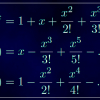Free Online Productivity Tools
i2Speak
i2Symbol
i2OCR
iTex2Img
iWeb2Print
iWeb2Shot
i2Type
iPdf2Split
iPdf2Merge
i2Bopomofo
i2Arabic
i2Style
i2Image
i2PDF
iLatex2Rtf
Sci2ools
339
click to vote
Lecture Notes
Numerical Methods Course Notes
"These notes were originally prepared during Fall quarter 2003 for UCSD Math 174, Numerical Methods."
Bisection | Finite Differences | Gaussian Elimination | Least Squares | Numerical Analysis | Polynomial Interpolation | Taylor's Theorem | The Definite Integral |
| Added | 18 Feb 2009 |
| Updated | 18 Feb 2009 |
| Year | 2004 |
| Authors | Steven E. Pav |
Table of Contents
1.1 Taylor's Theorem
1.1 Taylor's Theorem
1.2 Loss of Significance
1.3 Vector Spaces, Inner Products, Norms
1.3.1 Vector Space
1.3.2 Inner Products
1.3.3 Norms
1.4 Eigen values
1.4.1 Matrix Norms
Exercises
2.1 Getting Started
2.2 Useful Commands
2.3 Programming and Control
2.3.1 Logical Forks and Control
2.4 Plotting
Exercises
3.1 Gaussian Elimination with Naive Pivoting
3.1.1 Elementary Row Operations
3.1.2 Algorithm Terminology
3.1.3 Algorithm Problems
3.2 Pivoting Strategies for Gaussian Elimination
3.2.1 Scaled Partial Pivoting
3.2.2 An Example
3.2.3 Another Example and A Real Algorithm
3.3 LU Factorization
3.3.1 An Example
3.3.2 Using LU Factorizations
3.3.3 Some Theory
3.3.4 Computing Inverses
3.4 Iterative Solutions
3.4.1 An Operation Count for Gaussian Elimination
3.4.2 Dividing by Multiplying
3.4.3 Impossible Iteration
3.4.4 Richardson Iteration
3.4.5 Jacobi Iteration
3.4.6 Gauss Seidel Iteration
3.4.7 Error Analysis
3.4.8 A Free Lunch?
Exercises
4.1 Bisection
4.1.1 Modifications
4.1.2 Convergence
4.2 Newton's Method
4.2.1 Implementation
4.2.2 Problems
4.2.3 Convergence
4.2.4 Using Newton's Method
4.3 Secant Method
4.3.1 Problems
4.3.2 Convergence
Exercises
5.1 Polynomial Interpolation
5.1.1 Lagranges Method
5.1.2 Newton's Method
5.1.3 Newton's Nested Form
5.1.4 Divided Differences
5.2 Errors in Polynomial Interpolation
5.2.1 Interpolation Error Theorem
5.2.2 Interpolation Error for Equally Spaced Nodes
Exercises
6.1 First and Second Degree Splines
6.1.1 First Degree Spline Accuracy
6.1.2 Second Degree Splines
6.1.3 Computing Second Degree Splines
6.2 (Natural) Cubic Splines
6.2.1 Why Natural Cubic Splines?
6.2.2 Computing Cubic Splines
6.3 B Splines
Exercises
7.1 Finite Differences
7.1.1 Approximating the Second Derivative
7.2 Richardson Extrapolation
7.2.1 Abstracting Richardson's Method
7.2.2 Using Richardson Extrapolation
Exercises
8.1 The Definite Integral
8.1.1 Upper and Lower Sums
8.1.2 Approximating the Integral
8.1.3 Simple and Composite Rules
8.2 Trapezoidal Rule
8.2.1 How Good is the Composite Trapezoidal Rule?
8.2.2 Using the Error Bound
8.3 Romberg Algorithm
8.3.1 Recursive Trapezoidal Rule
8.4 Gaussian Quadrature
8.4.1 Determining Weights (Lagrange Polynomial Method)
8.4.2 Determining Weights (Method of Undetermined Coefficients)
8.4.3 Gaussian Nodes
8.4.4 Determining Gaussian Nodes
8.4.5 Reinventing the Wheel
Exercises
9.1 Least Squares
9.1.1 The Definition of Ordinary Least Squares
9.1.2 Linear Least Squares
9.1.3 Least Squares from Basis Functions
9.2 Orthonormal Bases
9.2.1 Alternatives to Normal Equations
9.2.2 Ordinary Least Squares in octave/Matlab
9.3 Orthogonal Least Squares
9.3.1 Computing the Orthogonal Least Squares Approximant
9.3.2 Principal Component Analysis
Exercises
10.1 Elementary Methods
10.1.1 Integration and `Stepping'
10.1.2 Taylor's Series Methods
10.1.3 Euler's Method
10.1.4 Higher Order Methods
10.1.5 Errors
10.1.6 Stability
10.1.7 Backwards Euler's Method
10.2 Runge-Kutta Methods
10.2.1 Taylor's Series Redux
10.2.2 Deriving the Runge-Kutta Methods
10.2.3 Examples
10.3 Systems of ODEs
10.3.1 Larger Systems
10.3.2 Recasting Single ODE Methods
10.3.3 It's Only Systems
10.3.4 It's Only Autonomous Systems
Exercises Comments (0)



